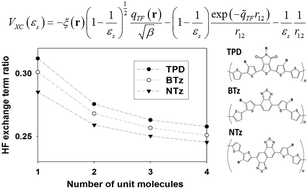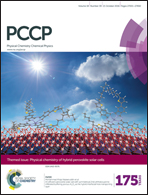Application of the dielectric-dependent screened exchange potential approach to organic photocell materials
Abstract
This paper discusses the fundamental features of the dielectric-dependent screened exchange potential approach for organic molecules and photocell materials. The energy difference (gap) between the highest occupied molecular orbital (HOMO) and the lowest unoccupied molecular orbital (LUMO) is a key factor when designing organic photocell materials. The magnitude of this energy gap strongly depends on the ratio of the Hartree–Fock (HF) exchange term combined with hybrid density functional theory (DFT) functionals. In ordinary hybrid DFT functionals, the HF exchange term ratio is often determined empirically and a constant value is employed for all materials. Conversely, the dielectric-dependent exchange potential approach employs a system-dependent value for this parameter, which is proportional to the inverse of the dielectric constant. The organic materials examined in this paper take different dielectric constant values according to their material types and unit lengths; therefore, their HF exchange ratios are also different. This paper discusses the relationship between the energy gaps, the dielectric constants, and the HF exchange ratios in the dielectric-dependent screened exchange potential approach. For a series of acene-type compounds, it was found that the HOMO–LUMO gap decreased when their conjugation systems are extended. The dielectric-dependent screened exchange potential approach demonstrated that the values of the dielectric constants of the compounds increased; consequently, the HF exchange ratio decreased. Similar results were obtained for a series of thiophene-based donor molecules. The calculated values were compared with those obtained via experimental measurements. We found that although the theoretical calculations of the HOMO–LUMO gap usually overestimate experimental optical gaps, a better agreement between the experimental and calculated values can be obtained if we correct for the exciton binding energy.


 Please wait while we load your content...
Please wait while we load your content...